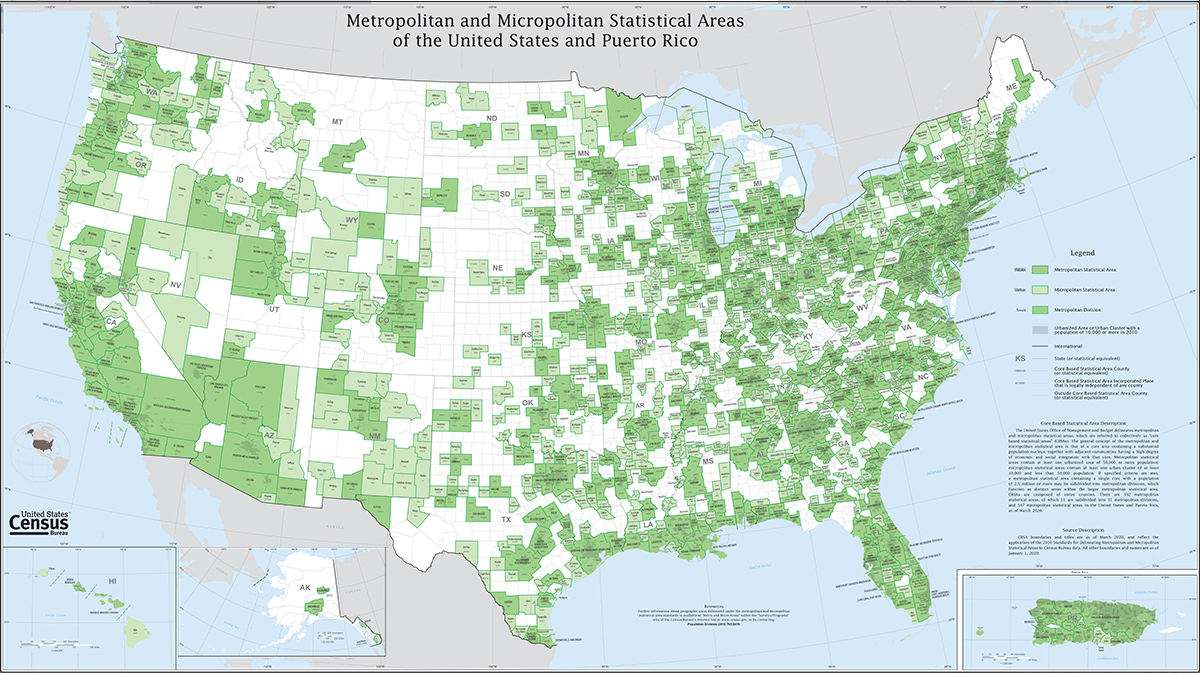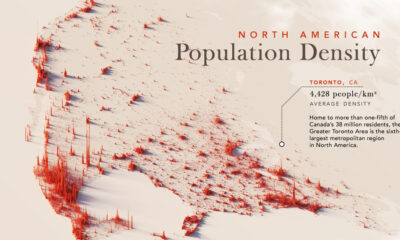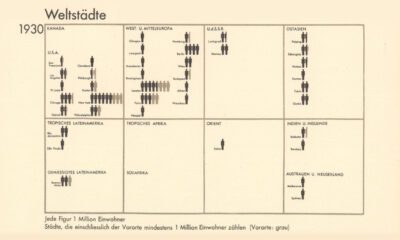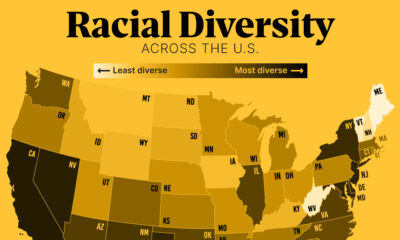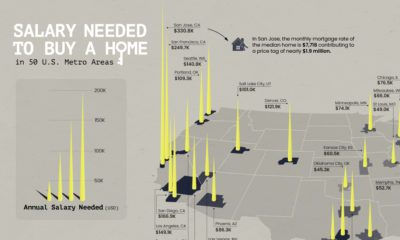Misc
This Giant Map Shows All the Metropolitan Areas in the U.S.
This Giant Map Shows All the Metropolitan Areas in the U.S.
The United States is the third most populous country in the world, made up of close to 20,000 cities and towns, and 333 million individuals.
Dividing these population clusters into a coherent framework of statistical areas is no small feat, and the U.S. Census Bureau’s latest map shows just how complex of a task it is.
This enormous map—which covers the entire country, including Puerto Rico—includes 392 metropolitan statistical areas and 547 micropolitan statistical areas.
For reference, here are all the current metropolitan statistical areas in the United States, organized by population:
| Rank | Metropolitan statistical area | Population (2020) | Change since 2010 |
|---|---|---|---|
| 1 | New York-Newark-Jersey City, NY-NJ-PA MSA | 20,140,470 | 6.58% |
| 2 | Los Angeles-Long Beach-Anaheim, CA MSA | 13,200,998 | 2.90% |
| 3 | Chicago-Naperville-Elgin, IL-IN-WI MSA | 9,618,502 | 1.66% |
| 4 | Dallas-Fort Worth-Arlington, TX MSA | 7,637,387 | 19.96% |
| 5 | Houston-The Woodlands-Sugar Land, TX MSA | 7,122,240 | 20.30% |
| 6 | Washington-Arlington-Alexandria, DC-VA-MD-WV MSA | 6,385,162 | 13.02% |
| 7 | Philadelphia-Camden-Wilmington, PA-NJ-DE-MD MSA | 6,245,051 | 4.69% |
| 8 | Miami-Fort Lauderdale-West Palm Beach, FL MSA | 6,138,333 | 10.31% |
| 9 | Atlanta-Sandy Springs-Alpharetta, GA MSA | 6,089,815 | 15.19% |
| 10 | Boston-Cambridge-Newton, MA-NH MSA | 4,941,632 | 8.55% |
| 11 | Phoenix-Mesa-Chandler, AZ MSA | 4,845,832 | 15.57% |
| 12 | San Francisco-Oakland-Berkeley, CA MSA | 4,749,008 | 9.54% |
| 13 | Riverside-San Bernardino-Ontario, CA MSA | 4,599,839 | 8.88% |
| 14 | Detroit–Warren–Dearborn, MI MSA | 4,392,041 | 2.23% |
| 15 | Seattle-Tacoma-Bellevue, WA MSA | 4,018,762 | 16.83% |
| 16 | Minneapolis-St. Paul-Bloomington, MN-WI MSA | 3,690,261 | 10.26% |
| 17 | San Diego-Chula Vista-Carlsbad, CA MSA | 3,298,634 | 6.57% |
| 18 | Tampa-St. Petersburg-Clearwater, FL MSA | 3,175,275 | 14.09% |
| 19 | Denver-Aurora-Lakewood, CO MSA | 2,963,821 | 16.53% |
| 20 | Baltimore-Columbia-Towson, MD MSA | 2,844,510 | 4.94% |
| 21 | St. Louis, MO-IL MSA | 2,820,253 | 1.17% |
| 22 | Orlando-Kissimmee-Sanford, FL MSA | 2,673,376 | 25.25% |
| 23 | Charlotte-Concord-Gastonia, NC-SC MSA | 2,660,329 | 18.56% |
| 24 | San Antonio-New Braunfels, TX MSA | 2,558,143 | 19.40% |
| 25 | Portland-Vancouver-Hillsboro, OR-WA MSA | 2,512,859 | 12.89% |
| 26 | Sacramento-Roseville-Folsom, CA MSA | 2,397,382 | 11.55% |
| 27 | Pittsburgh, PA MSA | 2,370,930 | 0.62% |
| 28 | Austin-Round Rock-Georgetown, TX MSA | 2,283,371 | 33.04% |
| 29 | Las Vegas-Henderson-Paradise, NV MSA | 2,265,461 | 16.10% |
| 30 | Cincinnati, OH-KY-IN MSA | 2,256,884 | 5.58% |
| 31 | Kansas City, MO-KS MSA | 2,192,035 | 9.09% |
| 32 | Columbus, OH MSA | 2,138,926 | 12.46% |
| 33 | Indianapolis-Carmel-Anderson, IN MSA | 2,111,040 | 11.82% |
| 34 | Cleveland-Elyria, OH MSA | 2,088,251 | 0.53% |
| 35 | San Juan-Bayamón-Caguas, PR Metropolitan Statistical Area | 2,002,906 | -14.77% |
| 36 | San Jose-Sunnyvale-Santa Clara, CA MSA | 2,000,468 | 8.90% |
| 37 | Nashville-Davidson–Murfreesboro–Franklin, TN MSA | 1,989,519 | 20.86% |
| 38 | Virginia Beach-Norfolk-Newport News, VA-NC MSA | 1,799,674 | 5.00% |
| 39 | Providence-Warwick, RI-MA MSA | 1,676,579 | 4.73% |
| 40 | Jacksonville, FL MSA | 1,605,848 | 19.34% |
| 41 | Milwaukee-Waukesha, WI MSA | 1,574,731 | 1.21% |
| 42 | Oklahoma City, OK MSA | 1,425,695 | 13.78% |
| 43 | Raleigh-Cary, NC MSA | 1,413,982 | 25.08% |
| 44 | Memphis, TN-MS-AR MSA | 1,337,779 | 1.65% |
| 45 | Richmond, VA MSA | 1,314,434 | 10.78% |
| 46 | Louisville/Jefferson County, KY-IN MSA | 1,285,439 | 6.88% |
| 47 | New Orleans-Metairie, LA MSA | 1,271,845 | 6.89% |
| 48 | Salt Lake City, UT MSA | 1,257,936 | 15.63% |
| 49 | Hartford-East Hartford-Middletown, CT MSA | 1,213,531 | 0.09% |
| 50 | Buffalo-Niagara Falls, NY MSA | 1,166,902 | 2.76% |
| 51 | Birmingham-Hoover, AL MSA | 1,115,289 | 5.11% |
| 52 | Rochester, NY MSA | 1,090,135 | 0.97% |
| 53 | Grand Rapids-Kentwood, MI MSA | 1,087,592 | 9.45% |
| 54 | Tucson, AZ MSA | 1,043,433 | 6.44% |
| 55 | Urban Honolulu, HI MSA | 1,016,508 | 6.64% |
| 56 | Tulsa, OK MSA | 1,015,331 | 8.30% |
| 57 | Fresno, CA MSA | 1,008,654 | 8.40% |
| 58 | Worcester, MA-CT MSA | 978,529 | 6.71% |
| 59 | Omaha-Council Bluffs, NE-IA MSA | 967,604 | 11.82% |
| 60 | Bridgeport-Stamford-Norwalk, CT MSA | 957,419 | 4.43% |
| 61 | Greenville-Anderson, SC MSA | 928,195 | 12.63% |
| 62 | Albuquerque, NM MSA | 916,528 | 3.32% |
| 63 | Bakersfield, CA MSA | 909,235 | 8.29% |
| 64 | Albany-Schenectady-Troy, NY MSA | 899,262 | 3.28% |
| 65 | Knoxville, TN MSA | 879,773 | 7.96% |
| 66 | McAllen-Edinburg-Mission, TX MSA | 870,781 | 12.39% |
| 67 | Baton Rouge, LA MSA | 870,569 | 5.41% |
| 68 | El Paso, TX MSA | 868,859 | 8.05% |
| 69 | New Haven-Milford, CT MSA | 864,835 | 0.27% |
| 70 | Allentown-Bethlehem-Easton, PA-NJ MSA | 861,889 | 4.96% |
| 71 | Oxnard-Thousand Oaks-Ventura, CA MSA | 843,843 | 2.49% |
| 72 | North Port-Sarasota-Bradenton, FL MSA | 833,716 | 18.72% |
| 73 | Columbia, SC MSA | 829,470 | 8.06% |
| 74 | Dayton-Kettering, OH MSA | 814,049 | 1.85% |
| 75 | Charleston-North Charleston, SC MSA | 799,636 | 20.32% |
| 76 | Stockton, CA MSA | 779,233 | 13.71% |
| 77 | Greensboro-High Point, NC MSA | 776,566 | 7.29% |
| 78 | Boise City, ID MSA | 764,718 | 24.03% |
| 79 | Cape Coral-Fort Myers, FL MSA | 760,822 | 22.96% |
| 80 | Colorado Springs, CO MSA | 755,105 | 16.96% |
| 81 | Little Rock-North Little Rock-Conway, AR MSA | 748,031 | 6.90% |
| 82 | Lakeland-Winter Haven, FL MSA | 725,046 | 20.42% |
| 83 | Des Moines-West Des Moines, IA MSA | 709,466 | 16.98% |
| 84 | Akron, OH MSA | 702,219 | -0.14% |
| 85 | Springfield, MA MSA | 699,162 | 0.90% |
| 86 | Poughkeepsie-Newburgh-Middletown, NY MSA | 697,221 | 4.02% |
| 87 | Ogden-Clearfield, UT MSA | 694,863 | 16.36% |
| 88 | Madison, WI MSA | 680,796 | 12.45% |
| 89 | Winston-Salem, NC MSA | 675,966 | 5.52% |
| 90 | Provo-Orem, UT MSA | 671,185 | 27.41% |
| 91 | Deltona-Daytona Beach-Ormond Beach, FL MSA | 668,921 | 13.32% |
| 92 | Syracuse, NY MSA | 662,057 | -0.08% |
| 93 | Durham-Chapel Hill, NC MSA | 649,903 | 15.18% |
| 94 | Wichita, KS MSA | 647,610 | 3.94% |
| 95 | Toledo, OH MSA | 646,604 | -0.74% |
| 96 | Augusta-Richmond County, GA-SC MSA | 611,000 | 8.17% |
| 97 | Palm Bay-Melbourne-Titusville, FL MSA | 606,612 | 11.64% |
| 98 | Jackson, MS MSA | 591,978 | 0.97% |
| 99 | Harrisburg-Carlisle, PA MSA | 591,712 | 7.69% |
| 100 | Spokane-Spokane Valley, WA MSA | 585,784 | 13.80% |
| 101 | Scranton–Wilkes-Barre, PA MSA | 567,559 | 0.70% |
| 102 | Chattanooga, TN-GA MSA | 562,647 | 6.53% |
| 103 | Lancaster, PA MSA | 552,984 | 6.46% |
| 104 | Modesto, CA MSA | 552,878 | 7.47% |
| 105 | Portland-South Portland, ME MSA | 551,740 | 7.32% |
| 106 | Fayetteville-Springdale-Rogers, AR MSA | 546,725 | 24.22% |
| 107 | Lansing-East Lansing, MI MSA | 541,297 | 1.24% |
| 108 | Youngstown-Warren-Boardman, OH-PA MSA | 541,243 | -4.34% |
| 109 | Fayetteville, NC MSA | 520,378 | 8.17% |
| 110 | Lexington-Fayette, KY MSA | 516,811 | 9.47% |
| 111 | Pensacola-Ferry Pass-Brent, FL MSA | 509,905 | 13.57% |
| 112 | Huntsville, AL MSA | 491,723 | 17.75% |
| 113 | Reno, NV MSA | 490,596 | 15.32% |
| 114 | Santa Rosa-Petaluma, CA MSA | 488,863 | 1.03% |
| 115 | Myrtle Beach-Conway-North Myrtle Beach, SC-NC MSA | 487,722 | 29.46% |
| 116 | Port St. Lucie, FL MSA | 487,657 | 14.98% |
| 117 | Lafayette, LA MSA | 478,384 | 2.49% |
| 118 | Springfield, MO MSA | 475,432 | 8.87% |
| 119 | Killeen-Temple, TX MSA | 475,367 | 17.29% |
| 120 | Visalia, CA MSA | 473,117 | 7.00% |
| 121 | Asheville, NC MSA | 469,015 | 10.39% |
| 122 | York-Hanover, PA MSA | 456,438 | 4.94% |
| 123 | Vallejo, CA MSA | 453,491 | 9.71% |
| 124 | Santa Maria-Santa Barbara, CA MSA | 448,229 | 5.74% |
| 125 | Salinas, CA MSA | 439,035 | 5.78% |
| 126 | Salem, OR MSA | 433,353 | 10.91% |
| 127 | Mobile, AL MSA | 430,197 | -0.09% |
| 128 | Reading, PA MSA | 428,849 | 4.23% |
| 129 | Manchester-Nashua, NH MSA | 422,937 | 5.54% |
| 130 | Corpus Christi, TX MSA | 421,933 | 4.17% |
| 131 | Brownsville-Harlingen, TX MSA | 421,017 | 3.64% |
| 132 | Fort Wayne, IN MSA | 419,601 | 7.97% |
| 133 | Salisbury, MD-DE MSA | 418,046 | 11.84% |
| 134 | Gulfport-Biloxi, MS MSA | 416,259 | 7.15% |
| 135 | Flint, MI MSA | 406,211 | -4.60% |
| 136 | Savannah, GA MSA | 404,798 | 16.45% |
| 137 | Peoria, IL MSA | 402,391 | -3.33% |
| 138 | Canton-Massillon, OH MSA | 401,574 | -0.70% |
| 139 | Anchorage, AK MSA | 398,328 | 4.60% |
| 140 | Beaumont-Port Arthur, TX MSA | 397,565 | 2.27% |
| 141 | Shreveport-Bossier City, LA MSA | 393,406 | -1.30% |
| 142 | Trenton-Princeton, NJ MSA | 387,340 | 5.68% |
| 143 | Montgomery, AL MSA | 386,047 | 3.07% |
| 144 | Davenport-Moline-Rock Island, IA-IL MSA | 384,324 | 1.22% |
| 145 | Tallahassee, FL MSA | 384,298 | 4.60% |
| 146 | Eugene-Springfield, OR MSA | 382,971 | 8.89% |
| 147 | Ocala, FL MSA | 375,908 | 13.47% |
| 148 | Naples-Marco Island, FL MSA | 375,752 | 16.87% |
| 149 | Ann Arbor, MI MSA | 372,258 | 7.97% |
| 150 | Hickory-Lenoir-Morganton, NC MSA | 365,276 | -0.06% |
| 151 | Huntington-Ashland, WV-KY-OH MSA | 359,862 | -2.98% |
| 152 | Fort Collins, CO MSA | 359,066 | 19.84% |
| 153 | Lincoln, NE MSA | 340,217 | 12.60% |
| 154 | Gainesville, FL MSA | 339,247 | 11.20% |
| 155 | Rockford, IL MSA | 338,798 | -3.04% |
| 156 | Boulder, CO MSA | 330,758 | 12.29% |
| 157 | Greeley, CO MSA | 328,981 | 30.12% |
| 158 | Columbus, GA-AL MSA | 328,883 | 6.85% |
| 159 | Green Bay, WI MSA | 328,268 | 7.19% |
| 160 | Spartanburg, SC MSA | 327,997 | 15.37% |
| 161 | South Bend-Mishawaka, IN-MI MSA | 324,501 | 1.65% |
| 162 | Lubbock, TX MSA | 321,368 | 10.51% |
| 163 | Clarksville, TN-KY MSA | 320,535 | 17.01% |
| 164 | Roanoke, VA MSA | 315,251 | 2.12% |
| 165 | Evansville, IN-KY MSA | 314,049 | 0.80% |
| 166 | Kingsport-Bristol, TN-VA MSA | 307,614 | -0.62% |
| 167 | Kennewick-Richland, WA MSA | 303,622 | 19.85% |
| 168 | Olympia-Lacey-Tumwater, WA MSA | 294,793 | 16.86% |
| 169 | Hagerstown-Martinsburg, MD-WV MSA | 293,844 | 9.18% |
| 170 | Utica-Rome, NY MSA | 292,264 | -2.38% |
| 171 | Duluth, MN-WI MSA | 291,638 | 0.34% |
| 172 | Crestview-Fort Walton Beach-Destin, FL MSA | 286,973 | 21.67% |
| 173 | Longview, TX MSA | 286,184 | 2.21% |
| 174 | Aguadilla-Isabela, PR Metropolitan Statistical Area | 286,064 | -15.72% |
| 175 | Wilmington, NC MSA | 285,905 | 12.17% |
| 176 | San Luis Obispo-Paso Robles, CA MSA | 282,424 | 4.74% |
| 177 | Merced, CA MSA | 281,202 | 9.93% |
| 178 | Waco, TX MSA | 277,547 | 9.80% |
| 179 | Sioux Falls, SD MSA | 276,730 | 21.23% |
| 180 | Cedar Rapids, IA MSA | 276,520 | 7.20% |
| 181 | Bremerton-Silverdale-Port Orchard, WA MSA | 275,611 | 9.75% |
| 182 | Atlantic City-Hammonton, NJ MSA | 274,534 | -0.01% |
| 183 | Erie, PA MSA | 270,876 | -3.45% |
| 184 | Santa Cruz-Watsonville, CA MSA | 270,861 | 3.23% |
| 185 | Amarillo, TX MSA | 268,761 | 6.68% |
| 186 | Tuscaloosa, AL MSA | 268,674 | 12.32% |
| 187 | Norwich-New London, CT MSA | 268,555 | -2.01% |
| 188 | College Station-Bryan, TX MSA | 268,248 | 17.31% |
| 189 | Laredo, TX MSA | 267,114 | 6.72% |
| 190 | Kalamazoo-Portage, MI MSA | 261,670 | 4.53% |
| 191 | Lynchburg, VA MSA | 261,593 | 3.55% |
| 192 | Charleston, WV MSA | 258,859 | -6.89% |
| 193 | Yakima, WA MSA | 256,728 | 5.55% |
| 194 | Fargo, ND-MN MSA | 249,843 | 19.67% |
| 195 | Binghamton, NY MSA | 247,138 | -1.82% |
| 196 | Fort Smith, AR-OK MSA | 244,310 | -1.57% |
| 197 | Appleton, WI MSA | 243,147 | 7.75% |
| 198 | Prescott Valley-Prescott, AZ MSA | 236,209 | 11.93% |
| 199 | Macon-Bibb County, GA MSA | 233,802 | 0.65% |
| 200 | Tyler, TX MSA | 233,479 | 11.33% |
| 201 | Topeka, KS MSA | 233,152 | -0.31% |
| 202 | Daphne-Fairhope-Foley, AL MSA | 231,767 | 27.16% |
| 203 | Barnstable Town, MA MSA | 228,996 | 6.07% |
| 204 | Bellingham, WA MSA | 226,847 | 12.78% |
| 205 | Rochester, MN MSA | 226,329 | 9.40% |
| 206 | Burlington-South Burlington, VT MSA | 225,562 | 6.77% |
| 207 | Lafayette-West Lafayette, IN MSA | 223,716 | 6.38% |
| 208 | Medford, OR MSA | 223,259 | 9.87% |
| 209 | Champaign-Urbana, IL MSA | 222,538 | 2.17% |
| 210 | Lake Charles, LA MSA | 222,402 | 11.42% |
| 211 | Charlottesville, VA MSA | 221,524 | 9.91% |
| 212 | Las Cruces, NM MSA | 219,561 | 4.94% |
| 213 | Hilton Head Island-Bluffton-Beaufort, SC MSA | 215,908 | 15.45% |
| 214 | Athens-Clarke County, GA MSA | 215,415 | 11.88% |
| 215 | Lake Havasu City-Kingman, AZ MSA | 213,267 | 6.53% |
| 216 | Chico, CA MSA | 211,632 | -3.80% |
| 217 | Ponce, PR Metropolitan Statistical Area | 211,465 | -19.48% |
| 218 | Columbia, MO MSA | 210,864 | 10.76% |
| 219 | Springfield, IL MSA | 208,640 | -0.73% |
| 220 | Johnson City, TN MSA | 207,285 | 4.31% |
| 221 | Houma-Thibodaux, LA MSA | 207,137 | -0.50% |
| 222 | Monroe, LA MSA | 207,104 | 1.31% |
| 223 | Elkhart-Goshen, IN MSA | 207,047 | 4.80% |
| 224 | Jacksonville, NC MSA | 204,576 | 15.08% |
| 225 | Yuma, AZ MSA | 203,881 | 4.15% |
| 226 | Gainesville, GA MSA | 203,136 | 13.05% |
| 227 | Florence, SC MSA | 199,964 | -2.73% |
| 228 | St. Cloud, MN MSA | 199,671 | 5.59% |
| 229 | Bend, OR MSA | 198,253 | 25.69% |
| 230 | Racine, WI MSA | 197,727 | 1.19% |
| 231 | Warner Robins, GA MSA | 191,614 | 14.33% |
| 232 | Saginaw, MI MSA | 190,124 | -5.02% |
| 233 | Punta Gorda, FL MSA | 186,847 | 16.80% |
| 234 | Terre Haute, IN MSA | 185,031 | -2.49% |
| 235 | Billings, MT MSA | 184,167 | 10.17% |
| 236 | Redding, CA MSA | 182,155 | 2.78% |
| 237 | Dover, DE MSA | 181,851 | 12.04% |
| 238 | Kingston, NY MSA | 181,851 | -0.35% |
| 239 | Joplin, MO MSA | 181,409 | 3.36% |
| 240 | Yuba City, CA MSA | 181,208 | 8.58% |
| 241 | Jackson, TN MSA | 180,504 | 0.45% |
| 242 | St. George, UT MSA | 180,279 | 30.53% |
| 243 | El Centro, CA MSA | 179,702 | 2.96% |
| 244 | Bowling Green, KY MSA | 179,639 | 13.27% |
| 245 | Abilene, TX MSA | 176,579 | 6.85% |
| 246 | Muskegon, MI MSA | 175,824 | 2.11% |
| 247 | Iowa City, IA MSA | 175,419 | 14.96% |
| 248 | Midland, TX MSA | 175,220 | 23.68% |
| 249 | Panama City, FL MSA | 175,216 | 3.77% |
| 250 | Auburn-Opelika, AL MSA | 174,241 | 24.24% |
| 251 | Arecibo, PR Metropolitan Statistical Area | 173,218 | -13.16% |
| 252 | Hattiesburg, MS MSA | 172,231 | 6.05% |
| 253 | Eau Claire, WI MSA | 172,007 | 6.74% |
| 254 | Oshkosh-Neenah, WI MSA | 171,730 | 2.84% |
| 255 | Burlington, NC MSA | 171,415 | 13.42% |
| 256 | Coeur d'Alene, ID MSA | 171,362 | 23.73% |
| 257 | Bloomington, IL MSA | 170,954 | 0.81% |
| 258 | Greenville, NC MSA | 170,243 | 1.25% |
| 259 | Waterloo-Cedar Falls, IA MSA | 168,461 | 0.38% |
| 260 | East Stroudsburg, PA MSA | 168,327 | -0.89% |
| 261 | Pueblo, CO MSA | 168,162 | 5.72% |
| 262 | Wausau-Weston, WI MSA | 166,428 | 2.22% |
| 263 | Blacksburg-Christiansburg, VA MSA | 166,378 | 2.10% |
| 264 | Odessa, TX MSA | 165,171 | 20.45% |
| 265 | Kahului-Wailuku-Lahaina, HI MSA | 164,754 | 6.41% |
| 266 | Janesville-Beloit, WI MSA | 163,687 | 2.09% |
| 267 | Bloomington, IN MSA | 161,039 | 0.93% |
| 268 | Jackson, MI MSA | 160,366 | 0.07% |
| 269 | Sebastian-Vero Beach, FL MSA | 159,788 | 15.76% |
| 270 | State College, PA MSA | 158,172 | 2.72% |
| 271 | Idaho Falls, ID MSA | 157,429 | 18.13% |
| 272 | Decatur, AL MSA | 156,494 | 1.73% |
| 273 | Madera, CA MSA | 156,255 | 3.57% |
| 274 | Chambersburg-Waynesboro, PA MSA | 155,932 | 4.22% |
| 275 | Grand Junction, CO MSA | 155,703 | 6.12% |
| 276 | Elizabethtown-Fort Knox, KY MSA | 155,572 | 4.88% |
| 277 | Santa Fe, NM MSA | 154,823 | 7.39% |
| 278 | Monroe, MI MSA | 154,809 | 1.83% |
| 279 | Niles, MI MSA | 154,316 | -1.59% |
| 280 | Vineland-Bridgeton, NJ MSA | 154,152 | -1.75% |
| 281 | Homosassa Springs, FL MSA | 153,843 | 8.93% |
| 282 | Hanford-Corcoran, CA MSA | 152,486 | -0.32% |
| 283 | Bangor, ME MSA | 152,199 | -1.12% |
| 284 | Alexandria, LA MSA | 152,192 | -1.12% |
| 285 | Dothan, AL MSA | 151,007 | 3.69% |
| 286 | Florence-Muscle Shoals, AL MSA | 150,791 | 2.48% |
| 287 | Jefferson City, MO MSA | 150,309 | 0.34% |
| 288 | Sioux City, IA-NE-SD MSA | 149,940 | 4.43% |
| 289 | Albany, GA MSA | 148,922 | -3.21% |
| 290 | Wichita Falls, TX MSA | 148,128 | -2.10% |
| 291 | Valdosta, GA MSA | 148,126 | 6.12% |
| 292 | Texarkana, TX-AR MSA | 147,519 | -1.13% |
| 293 | Logan, UT-ID MSA | 147,348 | 17.46% |
| 294 | Flagstaff, AZ MSA | 145,101 | 7.95% |
| 295 | Rocky Mount, NC MSA | 143,870 | -5.59% |
| 296 | Lebanon, PA MSA | 143,257 | 7.25% |
| 297 | Dalton, GA MSA | 142,837 | 0.43% |
| 298 | Morristown, TN MSA | 142,709 | 4.47% |
| 299 | Winchester, VA-WV MSA | 142,632 | 11.02% |
| 300 | Morgantown, WV MSA | 140,038 | 7.96% |
| 301 | La Crosse-Onalaska, WI-MN MSA | 139,627 | 4.46% |
| 302 | Wheeling, WV-OH MSA | 139,513 | -5.70% |
| 303 | Rapid City, SD MSA | 139,074 | 10.04% |
| 304 | Napa, CA MSA | 138,019 | 1.12% |
| 305 | Sumter, SC MSA | 136,700 | -4.02% |
| 306 | Springfield, OH MSA | 136,001 | -1.69% |
| 307 | Harrisonburg, VA MSA | 135,571 | 8.26% |
| 308 | Sherman-Denison, TX MSA | 135,543 | 12.13% |
| 309 | Battle Creek, MI MSA | 134,310 | -1.35% |
| 310 | Jonesboro, AR MSA | 134,196 | 10.88% |
| 311 | Manhattan, KS MSA | 134,046 | 5.48% |
| 312 | Bismarck, ND MSA | 133,626 | 20.79% |
| 313 | Johnstown, PA MSA | 133,472 | -7.10% |
| 314 | Carbondale-Marion, IL MSA | 133,435 | -4.11% |
| 315 | Hammond, LA MSA | 133,157 | 9.96% |
| 316 | The Villages, FL MSA | 129,752 | 38.89% |
| 317 | Mount Vernon-Anacortes, WA MSA | 129,523 | 10.80% |
| 318 | Pittsfield, MA MSA | 129,026 | -1.67% |
| 319 | Albany-Lebanon, OR MSA | 128,610 | 10.23% |
| 320 | Glens Falls, NY MSA | 127,039 | -1.46% |
| 321 | Lawton, OK MSA | 126,652 | -2.79% |
| 322 | Cleveland, TN MSA | 126,164 | 8.96% |
| 323 | Sierra Vista-Douglas, AZ MSA | 125,447 | -4.49% |
| 324 | Staunton, VA MSA | 125,433 | 5.85% |
| 325 | Ames, IA MSA | 125,252 | 8.12% |
| 326 | Mansfield, OH MSA | 124,936 | 0.37% |
| 327 | San Angelo, TX MSA | 122,888 | 8.78% |
| 328 | Altoona, PA MSA | 122,822 | -3.36% |
| 329 | New Bern, NC MSA | 122,168 | -3.65% |
| 330 | Wenatchee, WA MSA | 122,012 | 10.04% |
| 331 | Farmington, NM MSA | 121,661 | -6.45% |
| 332 | Owensboro, KY MSA | 121,559 | 5.93% |
| 333 | St. Joseph, MO-KS MSA | 121,467 | -4.60% |
| 334 | San Germán, PR Metropolitan Statistical Area | 120,280 | -12.50% |
| 335 | Lawrence, KS MSA | 118,785 | 7.18% |
| 336 | Sheboygan, WI MSA | 118,034 | 2.19% |
| 337 | Missoula, MT MSA | 117,922 | 7.89% |
| 338 | Goldsboro, NC MSA | 117,333 | -4.31% |
| 339 | Weirton-Steubenville, WV-OH MSA | 116,903 | -6.07% |
| 340 | Watertown-Fort Drum, NY MSA | 116,721 | 0.42% |
| 341 | Anniston-Oxford, AL MSA | 116,441 | -1.80% |
| 342 | Beckley, WV MSA | 115,079 | -7.86% |
| 343 | Twin Falls, ID MSA | 114,283 | 14.74% |
| 344 | Williamsport, PA MSA | 114,188 | -1.66% |
| 345 | California-Lexington Park, MD MSA | 113,777 | 8.20% |
| 346 | Brunswick, GA MSA | 113,495 | 1.00% |
| 347 | Michigan City-La Porte, IN MSA | 112,417 | 0.85% |
| 348 | Muncie, IN MSA | 111,903 | -4.90% |
| 349 | Lewiston-Auburn, ME MSA | 111,139 | 3.19% |
| 350 | Longview, WA MSA | 110,730 | 8.12% |
| 351 | Kankakee, IL MSA | 107,502 | -5.24% |
| 352 | Ithaca, NY MSA | 105,740 | 4.11% |
| 353 | Grand Forks, ND-MN MSA | 104,362 | 5.99% |
| 354 | Fond du Lac, WI MSA | 104,154 | 2.48% |
| 355 | Decatur, IL MSA | 103,998 | -6.11% |
| 356 | Bay City, MI MSA | 103,856 | -3.63% |
| 357 | Gettysburg, PA MSA | 103,852 | 2.41% |
| 358 | Mankato, MN MSA | 103,566 | 7.06% |
| 359 | Gadsden, AL MSA | 103,436 | -0.95% |
| 360 | Lima, OH MSA | 102,206 | -3.88% |
| 361 | Sebring-Avon Park, FL MSA | 101,235 | 2.48% |
| 362 | Cheyenne, WY MSA | 100,512 | 9.56% |
| 363 | Hot Springs, AR MSA | 100,180 | 4.33% |
| 364 | Dubuque, IA MSA | 99,266 | 5.99% |
| 365 | Rome, GA MSA | 98,584 | 2.35% |
| 366 | Victoria, TX MSA | 98,331 | 4.60% |
| 367 | Cape Girardeau, MO-IL MSA | 97,517 | 1.29% |
| 368 | Fairbanks, AK MSA | 95,655 | -1.97% |
| 369 | Ocean City, NJ MSA | 95,263 | -2.06% |
| 370 | Corvallis, OR MSA | 95,184 | 11.22% |
| 371 | Cumberland, MD-WV MSA | 95,044 | -7.99% |
| 372 | Pocatello, ID MSA | 94,896 | 4.68% |
| 373 | Mayagüez, PR Metropolitan Statistical Area | 93,412 | -19.62% |
| 374 | Parkersburg-Vienna, WV MSA | 89,490 | -3.43% |
| 375 | Grants Pass, OR MSA | 88,090 | 6.50% |
| 376 | Pine Bluff, AR MSA | 87,751 | -12.47% |
| 377 | Great Falls, MT MSA | 84,414 | 3.80% |
| 378 | Elmira, NY MSA | 84,148 | -5.27% |
| 379 | Yauco, PR Metropolitan Statistical Area | 84,112 | -21.63% |
| 380 | Kokomo, IN MSA | 83,658 | 1.09% |
| 381 | Midland, MI MSA | 83,494 | -0.16% |
| 382 | Bloomsburg-Berwick, PA MSA | 82,863 | -3.15% |
| 383 | Columbus, IN MSA | 82,208 | 7.05% |
| 384 | Hinesville, GA MSA | 81,424 | 4.50% |
| 385 | Casper, WY MSA | 79,955 | 5.97% |
| 386 | Grand Island, NE MSA | 77,038 | 5.93% |
| 387 | Danville, IL MSA | 74,188 | -9.11% |
| 388 | Guayama, PR Metropolitan Statistical Area | 72,240 | -14.22% |
| 389 | Lewiston, ID-WA MSA | 64,375 | 5.73% |
| 390 | Enid, OK MSA | 62,846 | 3.74% |
| 391 | Walla Walla, WA MSA | 62,584 | 6.47% |
| 392 | Carson City, NV MSA | 58,639 | 6.09% |
From Metro to Micro
The wide variety of population patterns around the country can make it tricky to divide regions up into uniform units. There are two main divisions to consider when viewing this map:
- Metropolitan Areas (metro areas) have at least one urban core area of at least 50,000 population. These are the largest population centers, sometimes encompassing many counties. In some instances, these metro areas are further subdivided into Metropolitan Divisions.
- Micropolitan Areas are the smallest areas measured on this map (indicated by a lighter shade of green). These smaller regions, which are generally located further away from large cities, have at least one urban core area of at least 10,000 but fewer than 50,000 people.
One thing to note about all of these definitions is that the cities in these regions must have significant ties to a neighboring region—usually in the form of commuting ties. This is what warrants binding adjacent counties into a measurable area.
Another unique layer of data on this map is the shading that indicates the actual urbanized area within metro areas. In the example of Atlanta-Sandy Springs-Alpharetta, it’s easy to see how urban sprawl has expanded the urban area into a number of neighboring counties.
With this context in mind, we’ll take a closer look at three points of interest on the map that show this concept at work with varying degrees of complexity.
Level One: The Central City
The Texas Triangle offers what is perhaps the most straightforward example of metro areas.
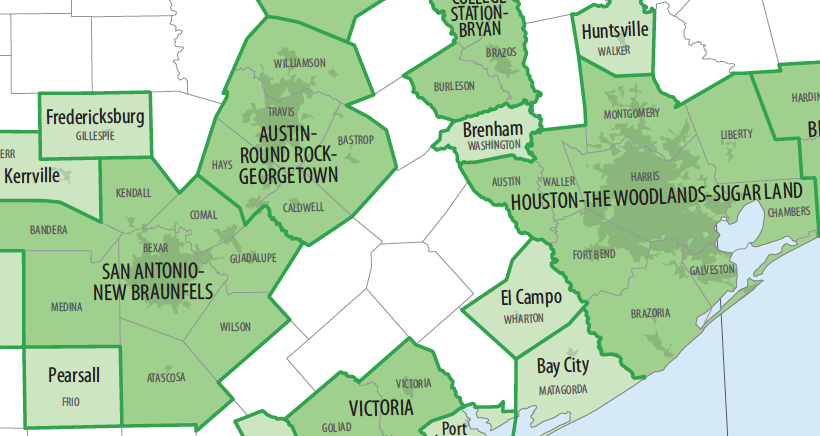
As seen above, Houston, Austin, and San Antonio anchor their respective regions, and surrounding counties are bundled into a metro area. The surrounding counties have all been identified as having ties to the central county, and, in some cases, the urban area has spread into the neighboring county over time.
Level Two: The City Cluster
The region anchored by Salt Lake City requires more thought to divide into statistical areas.
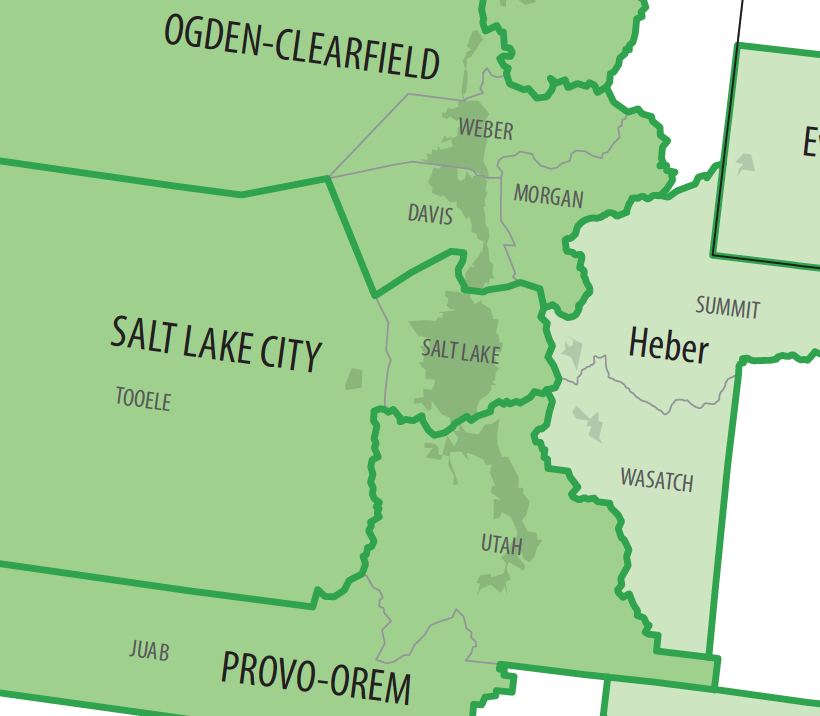
While there are a number of population centers in the area, including Salt Lake City, Provo, and Ogden, they all have enough of an economic “magnetic pull” to warrant splitting the region into distinct statistical areas.
Of course, regions are always evolving, and occasionally these areas are updated. Salt Lake City and Ogden were previously combined into a single metro area, but were separated in 2005.
Level Three: The Megaregion
New York City is the ultimate challenge for planners looking to categorize population centers into a neat and tidy statistical box.
For one, the contiguous urban area is massive, stretching from the west side of Long Island out to the east side of New Jersey. In addition to New York City itself, the metro area includes 19 other municipalities with over 100,000 people.
Next, NYC is an unparalleled economic magnet. Measuring commuting activity is a challenge because a wide variety of people visit the city for so many different reasons. The interconnectedness of the Northeast Megaregion also adds to the complexity.
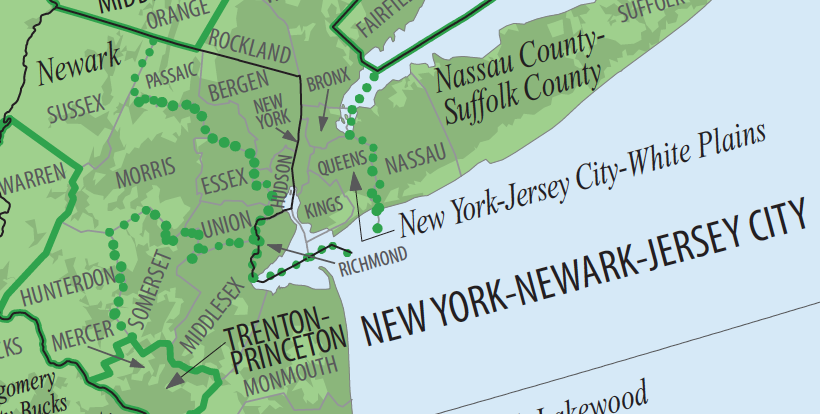
New York-Newark-Jersey City is such a big pie to carve up, that four of the country’s 11 metro divisions (as indicated by the italicized text and dotted lines) occur in this one area.
Blurring the Lines
Population patterns are constantly changing across the country, so the next version of this map may have a number of changes on it. Our “straightforward” Texas Triangle example may become tougher to divide up as the population boom continues in the region.
Here’s how the population of U.S. countries changed over the past decade:
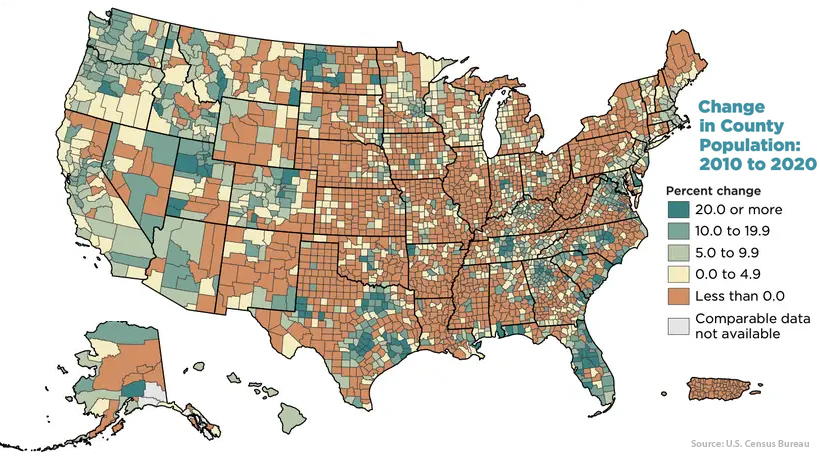
Further complicating matters is the rapid move to remote work and distributed teams. A key element of these census divisions are commuting ties. With work increasingly not bound by geographic limitations, it remains unclear how that trend will impact this type of statistical exercise in the future.
VC+
VC+: Get Our Key Takeaways From the IMF’s World Economic Outlook
A sneak preview of the exclusive VC+ Special Dispatch—your shortcut to understanding IMF’s World Economic Outlook report.

Have you read IMF’s latest World Economic Outlook yet? At a daunting 202 pages, we don’t blame you if it’s still on your to-do list.
But don’t worry, you don’t need to read the whole April release, because we’ve already done the hard work for you.
To save you time and effort, the Visual Capitalist team has compiled a visual analysis of everything you need to know from the report—and our upcoming VC+ Special Dispatch will be available exclusively to VC+ members on Thursday, April 25th.
If you’re not already subscribed to VC+, make sure you sign up now to receive the full analysis of the IMF report, and more (we release similar deep dives every week).
For now, here’s what VC+ members can expect to receive.
Your Shortcut to Understanding IMF’s World Economic Outlook
With long and short-term growth prospects declining for many countries around the world, this Special Dispatch offers a visual analysis of the key figures and takeaways from the IMF’s report including:
- The global decline in economic growth forecasts
- Real GDP growth and inflation forecasts for major nations in 2024
- When interest rate cuts will happen and interest rate forecasts
- How debt-to-GDP ratios have changed since 2000
- And much more!
Get the Full Breakdown in the Next VC+ Special Dispatch
VC+ members will receive the full Special Dispatch on Thursday, April 25th.
Make sure you join VC+ now to receive exclusive charts and the full analysis of key takeaways from IMF’s World Economic Outlook.
Don’t miss out. Become a VC+ member today.
What You Get When You Become a VC+ Member
VC+ is Visual Capitalist’s premium subscription. As a member, you’ll get the following:
- Special Dispatches: Deep dive visual briefings on crucial reports and global trends
- Markets This Month: A snappy summary of the state of the markets and what to look out for
- The Trendline: Weekly curation of the best visualizations from across the globe
- Global Forecast Series: Our flagship annual report that covers everything you need to know related to the economy, markets, geopolitics, and the latest tech trends
- VC+ Archive: Hundreds of previously released VC+ briefings and reports that you’ve been missing out on, all in one dedicated hub
You can get all of the above, and more, by joining VC+ today.
-

 Markets1 week ago
Markets1 week agoU.S. Debt Interest Payments Reach $1 Trillion
-

 Business2 weeks ago
Business2 weeks agoCharted: Big Four Market Share by S&P 500 Audits
-

 Real Estate2 weeks ago
Real Estate2 weeks agoRanked: The Most Valuable Housing Markets in America
-

 Money2 weeks ago
Money2 weeks agoWhich States Have the Highest Minimum Wage in America?
-

 AI2 weeks ago
AI2 weeks agoRanked: Semiconductor Companies by Industry Revenue Share
-

 Markets2 weeks ago
Markets2 weeks agoRanked: The World’s Top Flight Routes, by Revenue
-

 Demographics2 weeks ago
Demographics2 weeks agoPopulation Projections: The World’s 6 Largest Countries in 2075
-

 Markets2 weeks ago
Markets2 weeks agoThe Top 10 States by Real GDP Growth in 2023

